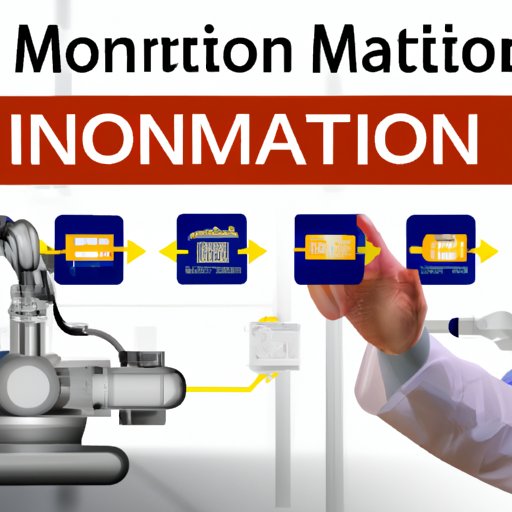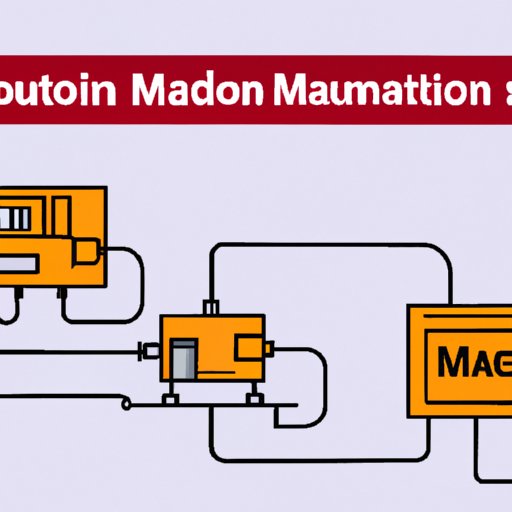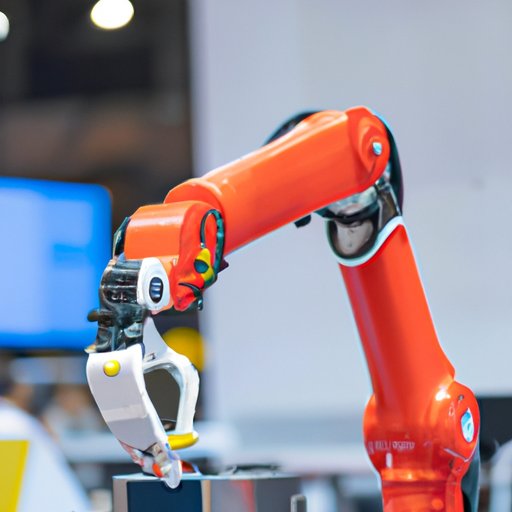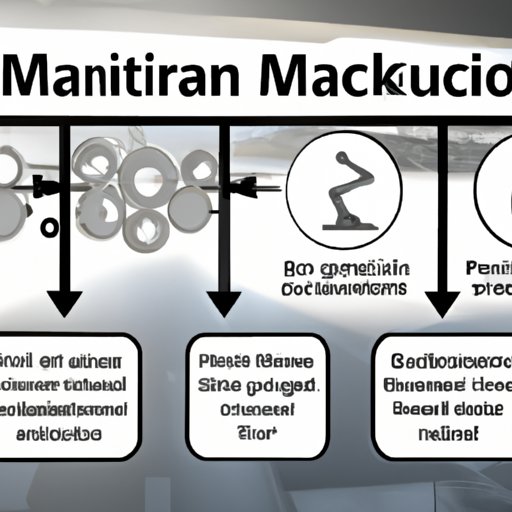Introduction
Manufacturing automation refers to the use of sophisticated computer-controlled equipment to automate the production process. This technology has allowed manufacturers to achieve greater levels of efficiency, cost savings, and improved quality control. It also reduces the risk of human error and increases the consistency of products. In this article, we will explore the benefits, basics, and future of manufacturing automation.

Exploring the Benefits of Manufacturing Automation
Manufacturing automation offers numerous advantages for manufacturers. The most significant benefit is increased efficiency. Automated processes are faster and more accurate than manual operations, allowing manufacturers to produce more products in a shorter amount of time. This can lead to higher output and lower costs. Additionally, automated processes require less labor, which can reduce labor costs.
Cost savings is another major benefit of manufacturing automation. Automated systems eliminate the need for manual labor, which can help to reduce overhead costs. Automation also allows manufacturers to reduce material waste, as automated systems are able to precisely control the amount of materials used in each product. This can lead to significant cost savings over time.
Improved quality control is another key advantage of manufacturing automation. Automated systems are able to detect any defects in the production process and make adjustments accordingly. This can help to ensure that products meet strict quality standards and reduce the risk of defective products entering the market.
Finally, manufacturing automation reduces the risk of human error. Automated systems are more precise and reliable than manual processes, which can help to reduce the risk of mistakes or errors in the production process. This can lead to fewer defective products and greater customer satisfaction.

A Guide to the Basics of Manufacturing Automation
The first step in understanding manufacturing automation is to have an overview of the process. Generally speaking, manufacturing automation involves the use of computers and robots to automate the production process. This can include tasks such as material handling, machine loading, and product assembly.
There are several different types of automation that can be used in the manufacturing process. Traditional automation involves the use of robots and other machines to perform repetitive tasks. Advanced automation, on the other hand, utilizes artificial intelligence (AI) to automate more complex tasks. Additionally, there are hybrid automation systems that combine traditional and advanced automation.
Understanding the technologies involved in manufacturing automation is essential. This includes both hardware and software components. Hardware components include robots, sensors, and controllers. Software components include programming languages, algorithms, and machine learning models.

The Role of Robotics in Manufacturing Automation
Robotics plays an important role in manufacturing automation. Robots are used to automate physical tasks that would otherwise be performed by humans. This can include tasks such as material handling, machine loading, and product assembly. Additionally, robots can be used to inspect products for defects and to package finished goods.
There are several advantages to using robots in manufacturing automation. Robots are able to work quickly and accurately, and they do not get tired or take breaks. This can lead to higher productivity and lower labor costs. Additionally, robots can operate in hazardous environments that may be unsafe for humans.
However, there are some challenges associated with using robots in manufacturing automation. For example, robots can be expensive to purchase and maintain. Additionally, programming robots can be difficult and time-consuming. Finally, robots may not be able to handle certain tasks that require flexibility and creativity.
How Artificial Intelligence is Revolutionizing Manufacturing Automation
Artificial intelligence (AI) is playing an increasingly important role in manufacturing automation. AI technology is being used to automate more complex tasks that would otherwise be too difficult for robots. This includes tasks such as product inspection, material sorting, and defect detection.
There are several advantages to using AI in manufacturing automation. AI systems are able to learn from their environment and adapt to changing conditions. This can lead to improved accuracy and efficiency. Additionally, AI systems can be programmed to identify patterns in data that would be too complex for humans to detect.
However, there are some challenges associated with using AI in manufacturing automation. AI systems can be expensive to develop and maintain. Additionally, AI systems may not always be reliable, as they are subject to bias and errors. Finally, AI systems may not be able to handle certain tasks that require human judgement.
The Future of Manufacturing Automation
Experts predict that manufacturing automation will continue to grow in the coming years. As AI technology continues to advance, it will become more widely adopted in the manufacturing industry. Additionally, the use of robotics and other automated systems is expected to increase as manufacturers look for ways to reduce costs and improve efficiency.
The implications of this growth will be far-reaching. Automation will lead to greater efficiency and cost savings. Additionally, it will allow manufacturers to produce higher-quality products at lower costs. Finally, it will reduce the risk of human error and create safer working conditions.
A Comparison of Different Types of Manufacturing Automation
When considering manufacturing automation, it is important to understand the differences between traditional automation and AI-driven automation. Traditional automation relies on robots and machines to perform repetitive tasks, while AI-driven automation uses AI technology to automate more complex tasks.
Each type of automation has its own pros and cons. Traditional automation is typically cheaper and easier to implement, but it is limited in its capabilities. AI-driven automation is more expensive and complex, but it offers more flexibility and accuracy.

Understanding the Costs and Benefits of Manufacturing Automation
When deciding whether or not to invest in manufacturing automation, it is important to consider the total cost of ownership. This includes the initial cost of purchasing and installing the system, as well as ongoing maintenance and support costs. Additionally, it is important to assess the potential return on investment of the system.
The best way to determine the cost and benefits of manufacturing automation is to conduct a thorough analysis. This should include an assessment of the current production process, an evaluation of the potential benefits of automation, and an estimation of the total cost of ownership. By doing so, manufacturers can make an informed decision about whether or not to invest in automation.
Conclusion
Manufacturing automation is a technology that has revolutionized the manufacturing industry. It offers numerous benefits, including increased efficiency, cost savings, improved quality control, and reduced human error. Additionally, it allows manufacturers to leverage the power of robotics and artificial intelligence to automate more complex tasks. Finally, it has the potential to dramatically increase productivity and reduce costs in the coming years.
When considering manufacturing automation, it is important to understand the costs and benefits of the technology. A thorough analysis should be conducted to determine the total cost of ownership and the potential return on investment. By understanding the benefits and risks associated with automation, manufacturers can make an informed decision about whether or not to invest in this technology.
(Note: Is this article not meeting your expectations? Do you have knowledge or insights to share? Unlock new opportunities and expand your reach by joining our authors team. Click Registration to join us and share your expertise with our readers.)
